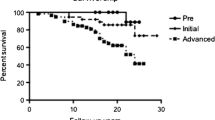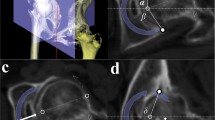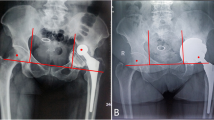Abstract
Introduction
We previously observed medial and/or lateral expansion of the subchondral bone in the acetabulum 3 years postoperatively in two out of three cases in which rotational acetabular osteotomy (RAO) was performed. Then we performed multiple drillings at the acetabular fossa in order to induce expansion of the medial subchondral bone in the acetabulum. The purpose of this study is to evaluate the effect of multiple drillings on early joint remodeling after RAO.
Patients and methods
Twenty-one women (21 joints) who had undergone RAO with multiple drillings at acetabular fossa (group D) were included. As a control group, 12 women (14 joints) without drillings in RAO procedure were observed (group C). The center-edge angle (CE angle), acetabular roof obliquity (AC angle), head lateralization index (HLI), and the angle between medial and lateral edge of acetabular roof (LOM angle) were measured on the radiographs preoperatively, at 1 month, 2 years postoperatively, and at the last follow-up.
Results
As regards the mean CE angle, AC angle, and HLI, there was no significant difference between the two groups. The mean LOM angle at 2 years and the last follow-up demonstrated significant difference between the two groups.
Interpretation
Biomechanical and anatomical changes after RAO cause increasing stress to the medial side of the acetabulum. Moreover, bone marrow-stimulating procedure at acetabular fossa might be beneficial to develop early joint remodeling affected by bone marrow derived cells such as mesenchymal stem cells.







Similar content being viewed by others
References
Frisbie DD, Oxford J, Southwood L, Trotter GW, Rodkey WG, Steadman JR, Goodnight JL, McIlwraith CW (2003) Early events in cartilage repair after subchondral bone microfracture. Clin Orthop 407:215–227
Hsin J, Saluja R, Eilert RE, Wiedel JD (1996) Evaluation of the biomechanics of the hip following a triple osteotomy of the innominate bone. J Bone Joint Surg (Am) 78:855–862
Johnson LL (1986) Arthroscopic abrasion arthroplasty historical and pathologic perspective: present status. Arthroscopy 2:54–69
Merle d’Aubigne R, Postel M (1954) Functional results of hip arthroplasty with acrylic prosthesis. J Bone Joint Surg (Am) 36:451–475
Mitchell N, Shepard N (1976) The resurfacing of adult rabbit articular cartilage by multiple perforations through the subchondral bone. J Bone Joint Surg (Am) 58:230–233
Mitchell N, Lee ER, Shepard N (1992) The clones of osteoarthritic cartilage. J Bone Joint Surg (Br) 74:33–38
Ninomiya S, Tagawa H (1984) Rotational acetabular osteotomy for the dysplastic hip. J Bone Joint Surg (Am) 66:430–436
Nishimori M, Deie M, Kanaya A, Exham H, Adachi N, Ochi M (2006) Repair of chronic osteochondral defects in the rat. A bone marrow-stimulating procedure enhanced by cultured allogenic bone marrow mesenchymal stromal cells. J Bone Joint Surg (Br) 88:1236–1244
Pridie KH (1959) A method of resurfacing osteoarthritic joints. J Bone Joint Surg (Br) 41:618–619
Shimogaki K, Yasunaga Y, Ochi M (2005) Rotational acetabular osteotomy. J Bone Joint Surg (Br) 87:1019–1023
Steadman JR, Rodkey WG, Rodrigo JJ (2001) Microfracture: surgical technique and rehabilitation to treat chondral defects. Clin Orthop 391(Suppl):362–369
Yasunaga Y, Ochi M, Ikuta Y, Shimogaki K, Dohi D (1997) Rotational acetabular osteotomies: a rabbit model. Arch Orthop Trauma Surg 116:74–76
Yasunaga Y, Ikuta Y, Shigenobu T, Nakamura S, Yamamoto S, Nakashiro J (2001) Rotational acetabular osteotomy for hip dysplasia: spontaneous medial enlargement of the acetabulum. Acta Orthop Scand 72:8–12
Yasunaga Y, Ochi M, Shimogaki K, Yamamoto S, Iwamori H (2004) Rotational acetabular osteotomy for hip dysplasia: 61 hips followed for 8–15 years. Acta Orthop Scand 75(1):10–15
Yasunaga Y, Ochi M, Terayama H, Tanaka R, Yamasaki T, Ishii Y (2006) Rotational acetabular osteotomy for advanced osteoarthritis secondary to dysplasia of the hip. J Bone Joint Surg (Am) 88:1915–1919
Acknowledgment
None of the authors received financial support for this study. No benefits in any form have been received or will be received from a commercial party related directly or indirectly to the subject of this paper.
Author information
Authors and Affiliations
Corresponding author
Rights and permissions
About this article
Cite this article
Yamasaki, T., Yasunaga, Y., Terayama, H. et al. Multiple drillings of the acetabular fossa induce early joint remodeling after rotational acetabular osteotomy for hip dysplasia. Arch Orthop Trauma Surg 128, 909–913 (2008). https://doi.org/10.1007/s00402-007-0493-6
Received:
Published:
Issue Date:
DOI: https://doi.org/10.1007/s00402-007-0493-6




